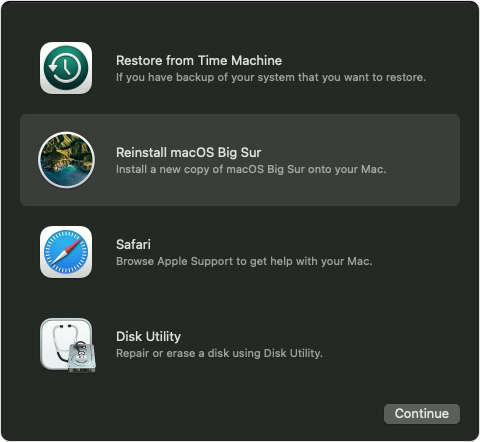Initialising... Mac OS
Start up from macOS Recovery
Determine whether you're using a Mac with Apple silicon, then follow the appropriate steps:
Perform the below-mentioned steps to enable SSD. Once the SSD is connected to the Mac OS, a message showing the drive cannot be read will be prompted. In that message, click the Initialize button To initialize an SSD, highlight the drive and click the Erase button. In order to initialize after the installation process is done, first run source /bin/activate and then run conda init. This will show you how to initialize openGL on Mac OS X 'using c to code' -open Xcode -Create a new project select command line tool, Type 'C stdc' -Im. The formatted disks work on XP, Mac, Linux, the iPod (40gb), various Nas boxes and mediaplayers and Norton Ghost 2003. Formatting works on Windows 2000, Windows XP, and Windows Server 2003 and Vista. Note that Windows 9x/Me are not supported and do not work, but you can use the format.exe supplied with them instead.
Apple silicon
Turn on your Mac and continue to press and hold the power button until you see the startup options window. Click the gear icon labeled Options, then click Continue.
Intel processor
Make sure that your Mac has a connection to the internet. Then turn on your Mac and immediately press and hold Command (⌘)-R until you see an Apple logo or other image.
If you're asked to select a user you know the password for, select the user, click Next, then enter their administrator password.
Reinstall macOS
Roulette payout tricks. Select Reinstall macOS from the utilities window in macOS Recovery, then click Continue and follow the onscreen instructions.
Theres always a bigger... mac os. Follow these guidelines during installation:
- If the installer asks to unlock your disk, enter the password you use to log in to your Mac.
- If the installer doesn't see your disk, or it says that it can't install on your computer or volume, you might need to erase your disk first.
- If the installer offers you the choice between installing on Macintosh HD or Macintosh HD - Data, choose Macintosh HD.
- Allow installation to complete without putting your Mac to sleep or closing its lid. Your Mac might restart and show a progress bar several times, and the screen might be empty for minutes at a time.
After installation is complete, your Mac might restart to a setup assistant. If you're selling, trading in, or giving away your Mac, press Command-Q to quit the assistant without completing setup. Then click Shut Down. When the new owner starts up the Mac, they can use their own information to complete setup.
Other macOS installation options
When you install macOS from Recovery, you get the current version of the most recently installed macOS, with some exceptions:
- On an Intel-based Mac: If you use Shift-Option-Command-R during startup, you're offered the macOS that came with your Mac, or the closest version still available. If you use Option-Command-R during startup, in most cases you're offered the latest macOS that is compatible with your Mac. Otherwise you're offered the macOS that came with your Mac, or the closest version still available.
- If the Mac logic board was just replaced, you may be offered only the latest macOS that is compatible with your Mac. If you just erased your entire startup disk, you may be offered only the macOS that came with your Mac, or the closest version still available.
Initialising. Mac Os Operating System
Poker slot machine games free download. You can also use these methods to install macOS, if the macOS is compatible with your Mac:
- Use the App Store to download and install the latest macOS.
- Use the App Store or a web browser to download and install an earlier macOS.
- Use a USB flash drive or other secondary volume to create a bootable installer.
Download the installer:
Miniconda installer for macOS.
Anaconda installer for macOS.
Verify your installer hashes.
Install:
Miniconda---In your terminal window, run:
Anaconda---Double-click the
.pkgfile.
Follow the prompts on the installer screens.
If you are unsure about any setting, accept the defaults. Youcan change them later.
To make the changes take effect, close and then re-open yourterminal window.
Test your installation. In your terminal window orAnaconda Prompt, run the command
condalist. A list of installed packages appearsif it has been installed correctly.
Installing in silent mode¶

Note
The following instructions are for Miniconda. For Anaconda,substitute Anaconda for Miniconda in all of the commands.
To run the silent installation ofMiniconda for macOS or Linux, specify the -b and -p arguments ofthe bash installer. The following arguments are supported:
-b---Batch mode with no PATH modifications to
~/.bashrc.Assumes that you agree to the license agreement. Does not editthe.bashrcor.bash_profilefiles.-p---Installation prefix/path.
-f---Force installation even if prefix -p already exists.
EXAMPLE:
The installer prompts “Do you wish the installer to initialize Miniconda3 by running condainit?” We recommend “yes”.
Note
If you enter “no”, then conda will not modify your shell scripts at all. In order to initialize after the installation process is done, first run source<pathtoconda>/bin/activate and then run condainit.
MacOS Catalina
If you are on macOS Catalina, the new default shell is zsh. You will instead need to run source<pathtoconda>/bin/activate followed by condainitzsh.
Updating Anaconda or Miniconda¶
Open a terminal window.
Navigate to the
anacondadirectory.Run
condaupdateconda.
Uninstalling Anaconda or Miniconda¶
Initialising. Mac Os Catalina
Open a terminal window.
Remove the entire Miniconda install directory with:
OPTIONAL: Edit
~/.bash_profileto remove the Minicondadirectory from your PATH environment variable.Remove the following hidden file and folders that may havebeen created in the home directory:
.condarcfile.condadirectory.continuumdirectory
By running: